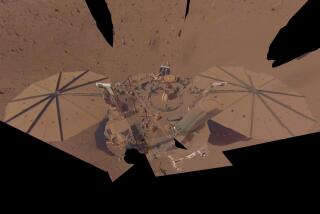Rock analysis turns up evidence of moon water
A new analysis of volcanic glass recovered from the moon decades ago found the rocks contain traces of the constituents of water, challenging a long-held notion that the moon is perfectly dry.
Using a technique that was not available when Apollo astronauts collected the minuscule rocks in the early 1970s, scientists were able to detect telltale signs of water trapped inside the pebble-like glass. Their discovery suggests that water was present deep within the moon when the pebbles were formed during violent lunar eruptions 3.3 billion to 3.6 billion years ago.
The analysis, published Thursday in the journal Nature, may cause scientists to rethink theories on how the moon was formed.
“The water that these guys have discovered is a scientific gold mine for us to figure out the history of . . . the moon,” said Jim Garvin, chief scientist at NASA’s Goddard Space Flight Center, who was not involved in the research.
The pebbles, about the size of a period on this page, are made of magnesium-rich green volcanic glass and iron-rich orange glass that solidified moments after eruption. They were recovered from the moon’s equatorial region during the Apollo 15 and Apollo 17 space missions.
Earlier studies of the pebbles detected the presence of sulfur and carbon, indicating the volcanic glass was formed in a fiery eruption. For the latest study, scientists measured the composition of the diminutive rocks molecule by molecule, using a technique 10 times more sensitive than that used in previous work.
They didn’t search for water directly because when water is incorporated into any rock it naturally separates into smaller components. So researchers looked for one of those components, hydrogen, which would signal the presence of water.
Testing the interior of the pebbles, scientists found trace amounts of hydrogen along with chlorine and fluorine, which, like carbon and sulfur, are found in rocks from explosive eruptions. The discovery of hydrogen alongside the other elements suggests that the water came from inside the moon and not from an external source, such as a comet.
Based on the amount of hydrogen found in the pebbles, scientists estimated the lunar magma contained 260 to 745 parts per million of water, similar to what is found in the Earth’s upper mantle.
“Up until our study, there was really no evidence for [indigenous] water on the moon,” said Erik Hauri, a staff scientist at the Carnegie Institution for Science and an author of the report.
The finding throws at least a little water on the currently favored hypothesis concerning the moon’s origin. Many scientists think the moon was formed when a large proto-planet slammed into Earth, sending into space molten debris that eventually became the moon. Scientists have long assumed that the heat created by the collision would have vaporized any water present and that the small gravitational field of the primeval moon would not have been strong enough to recapture the vapor.
Researchers said they eliminated solar wind as a possible source of the hydrogen found in the tiny rocks. Solar wind is a stream of charged particles, including hydrogen ions, that continually bombard the surface of the moon. If hydrogen from the solar wind seeped into the pebbles, it could give a false reading of water.
But in such a case, “you would expect high concentration on the surface which decreased toward the core,” said Alberto Saal, assistant professor of geological sciences at Brown University and lead author of the report. When Saal and colleagues analyzed a glass bead from its edge to its core, “what we found was exactly the opposite,” he said.
Some scientists think water may exist elsewhere on the moon. Ice may have been deposited by external sources such as comets, Hauri said. NASA plans to launch the Lunar Reconnaissance Orbiter this year to map the moon and look for surface water that could be hidden in permanently shadowed areas near the poles.
--






